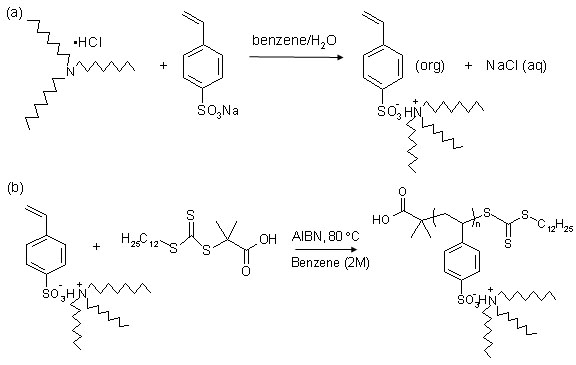Reports: G7
48488-G7 Investigation of the Relationships Between the Morphology and Transport Properties of Sulfonated Block Copolymers Containing Glassy Hydrophobic Blocks
Overview: The goal of this research is to understand how the morphology and chemical structure affect the bulk properties of water swollen neutral-sulfonated AB multiblock copolymer ion-exchange membranes. Block copolymers are efficient architectures for the fabrication of membranes. First, the microphase separation between the A and B blocks produces well-defined domains of low and high ionic concentration needed for ionic conduction. Second, the bridging of the blocks across separate domains produces a physically crosslinked network that resists swelling and dissolution in water. The two main parameters that are being investigated are the volume fraction of the sulfonated blocks, which primarily determines the microphase separated morphology, and their degree of sulfonation, which controls the intrinsic conductivity and hydrophilicity of the high ionic concentration domains. A range of parameter space is being investigated to determine which combinations of morphology and ionic content provide the best balance of properties, such as ionic conductivity, water uptake, mechanical strength and solvent permeability. These structure-property relationships will be crucial to the design of next generation ion-exchange membranes for applications like fuel cell membranes and water purification.
Research Progress: The bulk of the work in this past funding period has been to develop synthetic methods to produce well-defined AB multiblock copolymers with a sulfonated block and a neutral, glassy, hydrophobic block. Two major accomplishments were:
1. Preparation of poly(trithiocarbonate) reversible addition fragmentation chain transfer (RAFT) agents for the polymerization of (AB)n multiblock copolymers.
2. The direct polymerization of neutral-sulfonated AB block copolymers using commercially available monomers.
Poly(trithiocarbonate) RAFT agents were prepared by the condensation polymerization of a dicarboxylic acid functional RAFT agent and a diol (Figure 1a). This RAFT agent was then used for the synthesis of an (AB)n multiblock copolymer by the sequential free radical polymerization of two different monomers (Figure 1b). It was found that the polydispersities (PDI's) of the individual blocks were well-controlled with PDI's of ~ 1.2, while the overall PDI of the polymer was ~ 2. This approach greatly simplifies the preparation of (AB)n multiblock copolymers by RAFT polymerization because it reduces the number of polymerization steps compared to a conventional sequential polymerization with a mono- or di-functional RAFT agent.
| Figure 1. (a) Polymerization of poly(trithiocarbonate) RAFT agent. (b) Polymerization of (AB)n multiblock copolymer.
|

Sodium p-styrenesulfonate (SS-Na) was ion-exchanged with trioctylammmonium hydrochloride to produce a hydrophobic monomer trioctylammonium p-styrenesulfonate (SS-TOA). This monomer was polymerized by RAFT polymerization to produce poly(triocytlammonium p-styrene sulfonate) (PSS-TOA) homopolymers. These PSS-TOA homopolymers were then used as macro-RAFT agents for the polymerization of styrene to produce PSS-TOA-block-polystyrene block copolymers with low polydispersities (1.2 1.3). These polymers were ion-exchanged with aqueous sodium hydroxide solutions to obtain amphiphilic neutral-sulfonated block copolymers. In addition, the styrene and SS-TOA monomers can be copolymerized to vary the degree of sulfonation in the ionic block. This method has advantages for preparing neutral-sulfonated block copolymers compared to other methods. First, it avoids the harsh reaction conditions used in post-sulfonation reactions that can result in crosslinking or cleavage of the polymer chains. Second, the preparation of SS-TOA is less sensitive to the reaction conditions compared to styrene sulfonate esters.
|
Figure 2. (a) Preparation of SS-TOA monomer. (b) RAFT polymerization of SS-TOA. |

Significance of the Research: These synthetic methods allow the preparation of well-defined neutral-sulfonated block copolymers with independent control over both the volume fraction of the sulfonated block and the degree of sulfonation of the sulfonated block. Currently we are investigating the structure-property relationships between their chemical structure, morphology, and bulk properties of these polymers.
Impact of PRF Funding: These funds from the PRF have been used purchase research supplies and to support one graduate student (Yuqing Liu) during the past funding period. In addition the funds were used support the travel of a summer 2008 REU student (Kevin Pollock) to present his work at the Spring 2009 ACS meeting in Salt Lake City in the undergraduate poster session.




